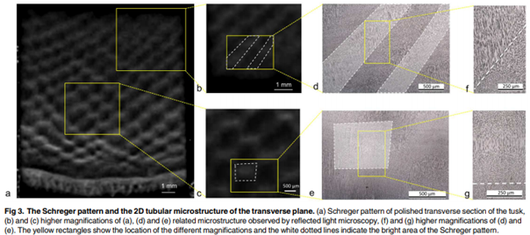Relation between the Macroscopic Pattern of Elephant Ivory and Its Three-Dimensional Micro-Tubular Network
Abstract
Macroscopic, periodic, dark and bright patterns are observed on sections of elephant tusk, in the dentin part (ivory). The motifs—also called Schreger pattern—vary depending on the orientation in the tusk: on sections perpendicular to the tusk axis, a checkerboard pattern is present whereas on sections longitudinal to it, alternating stripes are observed. This pattern has been used to identify elephant and mammoth ivory in archeological artifacts and informs on the continuous tissue growth mechanisms of tusk. However, its origin, assumed to be related to the 3D structure of empty microtubules surrounded by the ivory matrix has yet to be characterized unequivocally. Based on 2D observations of the ivory microtubules by means of a variety of imaging techniques of three different planes (transverse, longitudinal and tangential to the tusk axis), we show that the dark areas of the macroscopic pattern are due to tubules oblique to the surface whereas bright areas are related to tubules parallel to it. The different microstructures observed in the three planes as well as the 3D data obtained by SR-μCT analysis allow us to propose a 3D model of the microtubule network with helical tubules phase-shifted in the tangential direction. The phase shift is a combination of a continuous phase shift of π every 1 mm with a stepwise phase shift of π/2 every 500 μm. By using 3D modeling, we show how the 3D helical model better represents the experimental microstructure observed in 2D planes compared to previous models in the literature. This brings new information on the origin of the unique Schreger pattern of elephant ivory, crucial for better understanding how archaeological objects were processed and for opening new routes to rethink how biological materials are built.






